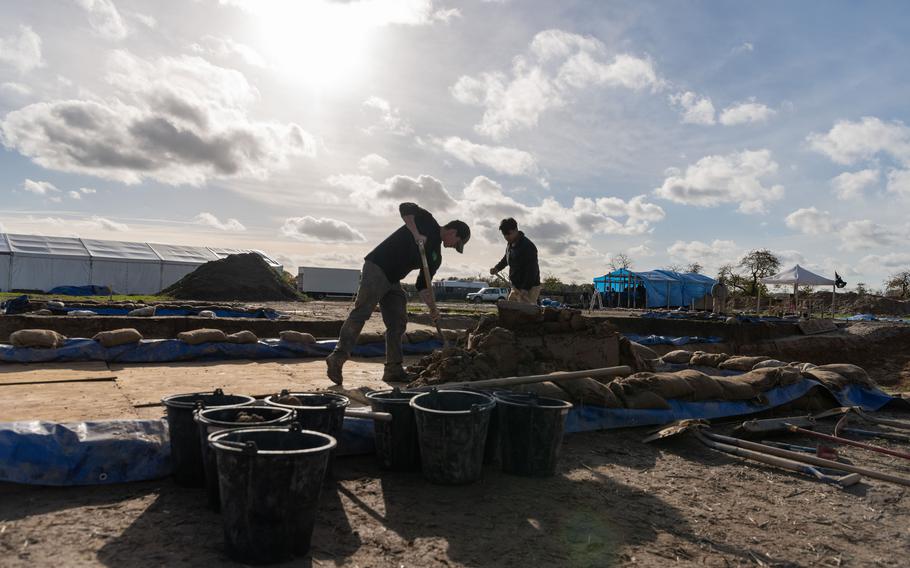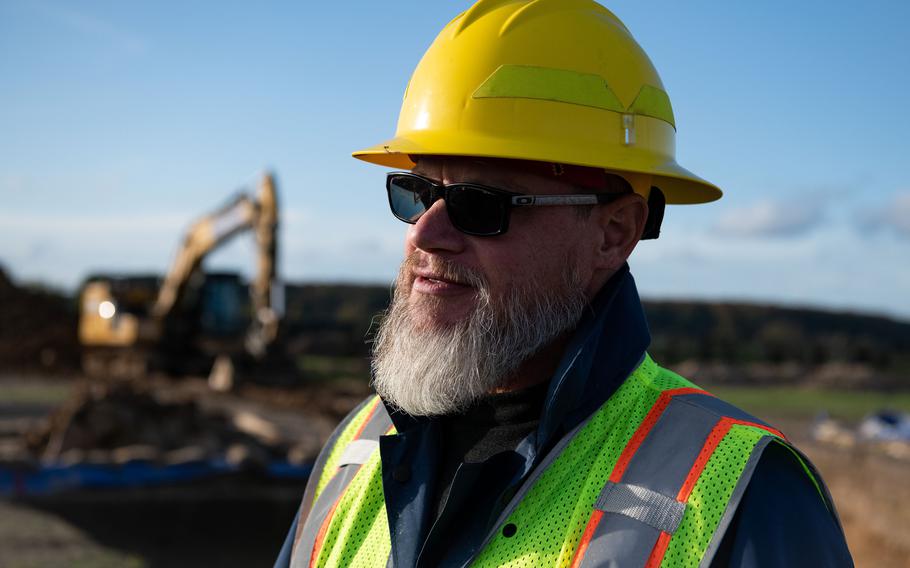
Army Cpl. Anthony Boulanger, left, and Army Spc. Alexis Jove, both with the 2nd Cavalry Regiment, shovel soil into buckets at an excavation site in Wistedt, Germany, Oct. 30, 2023. The soil will later be examined for airplane debris and potential human remains. (Phillip Walter Wellman/Stars and Stripes)
WISTEDT, Germany — U.S. service members have spent the past three months sifting through soil at a remote farm in northern Germany on a quest to solve an 80-year-old mystery.
They’re trying to confirm where a 10-man U.S. bomber crew crashed during World War II, so the airmen’s remains can be repatriated.
Most of the soldiers and airmen spend their days dumping buckets of thick clay over quarter-inch screens and washing it down with overhead water hoses.
Any material besides rocks remaining in the screen then is collected and examined.
“It gets monotonous, but it’s also really gratifying work because we’re finding all of these things and it feels like we’re making an impact towards the recovery mission,” said Tech. Sgt. Jonathan Gonzalez of the 786th Civil Engineer Squadron at Ramstein Air Base, about 350 miles southwest of the site.
With just weeks left in the mission and temperatures inching closer to freezing, the team is racing to unearth as much material as possible.
“We’ve been fighting through the weather and pushing our capabilities with heavy rains and a lot of unseasonably cold days,” said David Brown, a forensic archaeologist leading the excavation for the Defense POW/MIA Accounting Agency. “But I think we’re in good shape.”
In April 1944, about 200 aircraft from the U.S. 8th Air Force came under fire after bombing factories where fighter jets and synthetic oil deemed critical to Germany’s war effort were produced, according to the Defense Department.
Dozens of B-24H Liberator bombers were said to have been shot down, including one carrying four officers and six enlisted airmen that was last seen over Salzwedel, in what is today the state of Saxony-Anhalt.
U.S. forces later obtained German records that mentioned an air crash the same day outside the nearby village of Wistedt, and suspected that it was the 10-man crew’s plane.
But initial attempts to locate the crash site were futile. As the area fell into the hands of Soviet-controlled East Germany after the war, American personnel for decades were unable to conduct a comprehensive search.
In 2015 — the same year the Defense POW/MIA Accounting Agency opened a detachment in Germany to recover the remains of Americans who went missing in Europe during World War II — the agency began investigating the crash with a German research group.
Experts conducted research and investigations to pinpoint the Wistedt crash site, which eventually led to the discovery of surface debris on a farm just outside the village. An official recovery mission began in August.
Standing at the edge of the excavation pit, which is now over 10 feet deep, Brown said the black color of some of the soil was a result of it being burned by a plane crash.
The steep angle of the aircraft’s impact left it buried deep below the earth, and excavation has required heavy machinery. During his eight years with the agency, this is one of the largest excavations on which Brown has worked.
“We’re finding things every hour,” said Brown, an Army veteran.

David Brown, a forensic archaeologist for the Defense POW/MIA Accounting Agency, has been leading an excavation in Wistedt, Germany, since August that’s focused on recovering the remains of 10 U.S. service members who went missing in World War II. (Phillip Walter Wellman/Stars and Stripes)
Brown and Air Force veteran Rex Hodges are the only two civilians working at the site.
Hodges identifies aircraft parts and other items worn by the crew. A flak jacket, glove and helmet fragments and part of a first-aid box with English writing on it all indicate that an American aircraft went down here, he said.
Pieces of oxidized aluminum, chewed-up rubber and a portion of thick glass that once made up a plane’s windshield also were unearthed on a recent day, Hodges said.
Crash debris can provide additional evidence and help excavators pinpoint potential human remains.
Material resembling human bones already has been extracted and boxed. Some of what Brown catalogs at his field lab has been sent to Offutt Air Force Base, Neb., for DNA testing. The rest will be sent to the U.S. once the mission concludes later this month.
While the evidence looks encouraging, Brown said it’s too early to come to conclusions. The workers onsite did not want to name the crew members whose remains they are searching for out of concern that the findings may end up disappointing the families involved.
It likely will be several more months before DNA samples determine whether the Americans can be accounted for in Wistedt.
“You never know until way down the line, but hopefully in a year or so, we’ll find out that we were able to bring some people home,” said Army Capt. Jonathan Hootnick, who is in charge of the current team at the site. “It’s a huge honor for all of us to be part of this.”